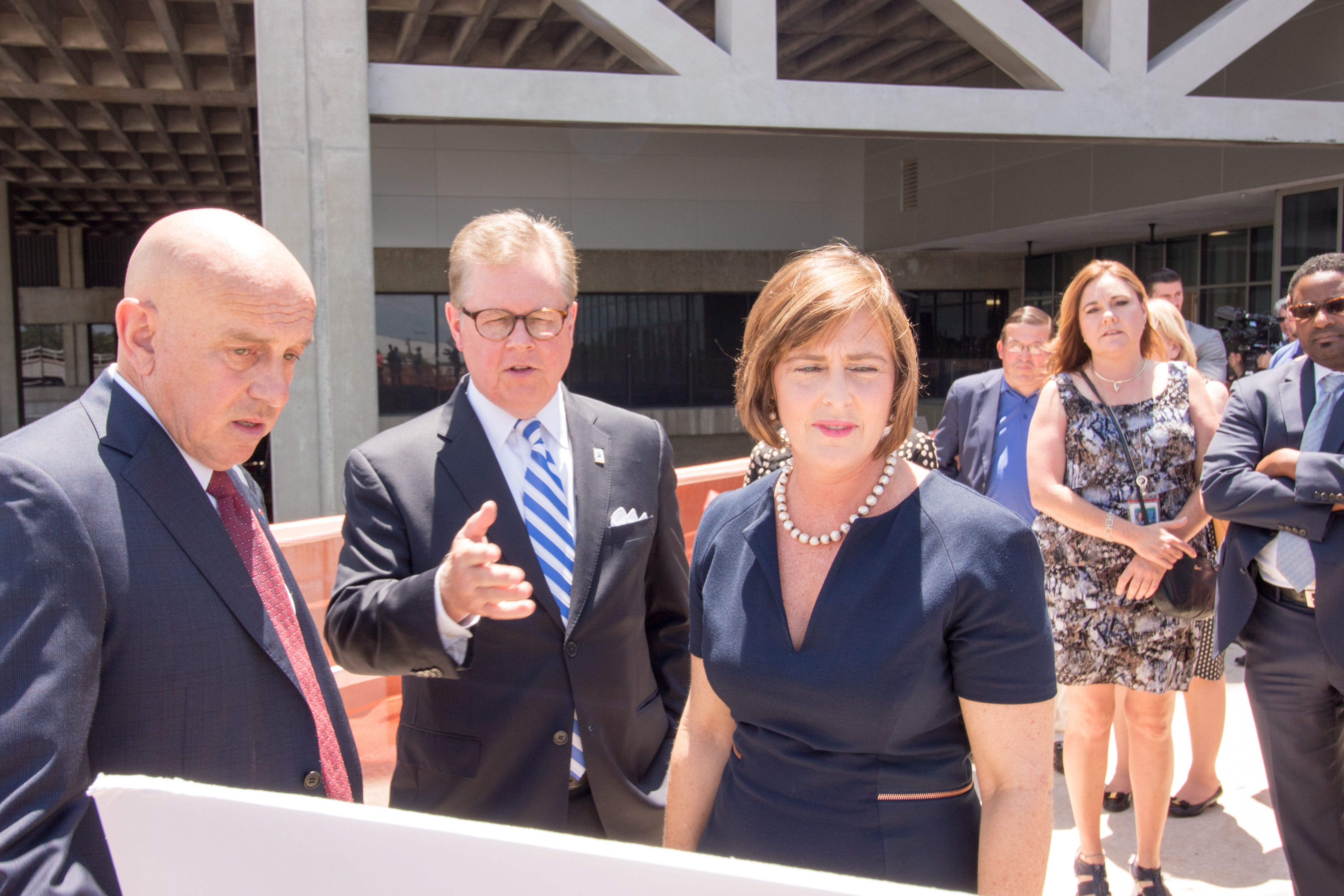By Sandy Smith
As airports continue to focus on an improved customer experience, they are looking beyond and outside of the box to pinpoint areas that could use improvement – even though there might not be any obvious need for changes. Figuring out what travelers need – before they have figured it out themselves – is what sets airports apart and leads to an airport becoming an experience and adventure, not just a waypoint.
Getting travelers in and out smoothly and providing creature comforts can make or break a traveler’s perception of the airport, too. This important leg of the customer journey requires skilled service providers who bring unique services. These valuable partners can provide much needed services when there’s been a flight delay or a connection missed. And they might just employ the first human a traveler speaks to on their journey.
The coming year will see these service providers continue to grow in importance to the traveler experience. HMSHost and Uber – both Platinum Plus ACI-NA members – are more than ready for the task ahead and want to help you be ready as well.
Food & Beverage and Retail Morphing Into Immersive Experiences
HMSHost Shares Insights from the Front Lines
Recently Steve Johnson picked up the phone to hear a story from a happy customer.
It was her 10th wedding anniversary and her husband wanted to celebrate at his favorite restaurant. The restaurant, Wicker Park Seafood & Sushi, just happened to be one of HMSHost’s restaurants in Chicago’s O’Hare International Airport.
That story was just one more piece of evidence of the changing face of airport food. As President and CEO of HMSHost, Johnson has had a front row seat to see hot dogs and pizza give way to a true dining experience – if that’s what the traveler wants. As he looks at 2019, it is clear that the traveler is firmly in control and HMSHost and airports are there to ensure that they get what they want. Top of that list: feeling like they’re actually in the city in which the airport resides.
“If you’re looking at where we’re headed in restaurants and food and beverage, we’re focused on an immersive, cultural experience,” Johnson said. “Local brands were the beginning of this process, where you’re trying to create a sense of place, a local feel.”
Food is no longer about filling the tanks after a long day of traveling or grabbing a sandwich for the plane. It’s about creating a dining experience that is worth bragging about.
“If it’s not Instagrammable, it’s not important,” Johnson said. “If they can take a picture of a well-done particular plate, something that their friends would not be able to experience, then we’ve done something.”
The move toward local brands has brought an evolution in HMSHost, too. The company has gone from operating around 100 brands eight years ago to well over 320. Instead of having one restaurant and bar in every airport, it will bring in local name plates, local foods. But that has brought changes, too.
“It took a few years to figure out how to translate local brands to airports,” Johnson said. “It’s a completely different business. Your timeframes are really different. Menus and processes have to change. You go into a 400-square-foot kitchen compared to 2,000. We also found that some of the best local restaurants had no standards or recipes. We had to start from scratch.”
NEW MEANING OF LOCAL
Locally harvested has grown alongside the local branding, and that trend will continue to expand into the coming year. Johnson attributes that to millennials, who want to know where their food comes from. It is an aspect of the overall evolution to more healthy options in the airport.
“Millennials look at things differently and they’re driving some of these changes toward a clean diet with less processed food,” Johnson said. “You make a pizza differently today. It used to be that every pizza made in an airport was from frozen dough. Today, it’s wheat flour, procured locally and made and cooked the same day. It’s made the process more complicated, but certainly more enjoyable.”
These days, most meats, dairies and proteins are procured less than 100 miles from each airport, Johnson said. “It’s changed our supply chain, but for the better.”
TECHNOLOGY DEMANDS
While the move toward local has created opportunities for memorable dining experiences, it has presented HMSHost with a dilemma: integrating technology into its operations. Since it operates restaurants under brand names, customers might be somewhat confused. Take Starbucks, for instance. Outside the airport, the customer can use the Starbucks app to preorder a drink. Not so inside the airport. But Johnson is determined to fix that in 2019.
“Mobile order and pay is probably the biggest gap in what we have today,” Johnson said. “You could be sitting in your office and pull out your phone and book a flight, call an Uber, go through TSA and board with your phone. When you land, you book your hotel and call another Uber. You can check into your hotel room with your phone. In that traveler journey, the only thing you can’t do is order a meal.”
It is a huge hurdle with 2,000 restaurants and 320 brands. “We need to be able to connect to their app through our system,” he said. “That digital journey and handshake is quite complicated.”
The company pilot tested 10 Starbucks with mobile order and pay in 2018 and expects to expand that more fully in 2019.
“You can order your Frappuccino as you come through security. It will tell you your drink will be ready in 12 minutes. You’ll be able to walk up, grab your drink and go. That’s the piece that we want to replicate to as many of our locations throughout the airport as possible.”
It is just one more way that HMSHost is attempting to meet the needs of the traveling customer. It is a juggling act, to be sure. For every person who wants to eat healthy, there is one who wants a treat while traveling. For every person wanting to take a respite and linger over a meal, there is another who needs to grab something in those few minutes on a layover. For every person who wants to be left alone to work (and recharge their phones and spirits) at a restaurant, there is another who enjoys the community table where they can meet fellow travelers. Community tables, by the way, are proving popular. “We don’t build a restaurant without them anymore,” Johnson said. So too are electrical plugs and WiFi; both are essential in every new construction, Johnson said.
Ultimately, it is about giving “customers the choice to decide what’s important,” he said.
He anticipates that choice may be available within the restaurant, too. “I envision the future where you ask, ‘Would you like full service or self service?’ The customers will be in full control of their dining experiences and can leave at their leisure. They won’t be dependent upon anyone to bring the check or return the credit card.”
Smoothing out any bumps throughout the traveler’s day is one of the most important roles that HMSHost plays for its airport and airline partners, Johnson said.
“If you think of a customer’s journey, they have shown up an hour and a half ahead of time, stood in line for 15 minutes to check their bag, gone through TSA and stood another 10-15 minutes. They’re pretty frustrated by the time they get to us. We get the brunt of it sometimes. It’s our job to understand that we can make or break the airport experience.”
Ultimately, the world of airport food has changed dramatically and Johnson finds himself hearing more stories like the anniversary trip for airport sushi.
“When I got into this business 20 years ago, if I told someone I worked in the food business in airports, they would make a face and say, ‘Did you lose a bet?’ When I say that today, they get a gleam in their eye and tell me about a great restaurant in a certain city. It’s no longer a punishment to eat at the airport. It can be a great thrill.”
And it is one that HMSHost is pushing to continue into 2019.
Ground and Air Transportation Goals Coming Together
Alignment Is in Commitment to the Customer, Says Uber
While airports focus on creating a happy customer experience onsite, Uber is focused on getting travelers out of the airport. Those goals aren’t as opposing as it might seem.
“Uber and airports are aligned around our commitment to the customer,” said Marcus Womack, Uber’s Director of Product Management. “We believe Uber, airports and airlines can and should be working together to solve the points of friction throughout the passenger journey.”
And for good reason. “Simply, customers have come to expect to have the option to take an Uber or other app-based rides to and from the airport,” he said.
Airports, with their dependable passenger load, are equally as important to Uber drivers. That’s why Uber has focused on expanding its partnerships around the globe. Currently, the company is in 500 airports around the world.
Solving issues for passengers, drivers and airports is a significant goal for Uber in 2019.
IMPROVING THE CUSTOMER EXPERIENCE
Airports haven’t always kept up with this rapidly evolving transition to ridesharing. The result has brought frustration for travelers, especially as they arrive at their destination airport. “We know that a big pain point for passengers is they don’t know where to find the pickup point. Further, they might not know when to request their ride if they don’t trust the driver’s ETA. This is often a function of staging lot location, congestion on the roadways, or confusing decision points for drivers in getting to the correct pickup location. Partnering together, Uber and airports can address this challenge to elevate the customer experience.”
Uber will focus on three areas to improve the experience for travelers in the coming year, Womack said. “First, we want to make it easier to find the pickup point through better wayfinding and signage. Once at the pickup point we want to make finding your driver fast and efficient. And most importantly, we want to reduce customer waiting times throughout the process and make it a stress-free experience.”
There are benefits to airports as well, such as improved efficiency and a reduction in environmental footprint.
Recently, Uber partnered with several ACI-NA members to define standards for a TNC wayfinding icon and nomenclature at airports. The result of extensive survey data, the consortium distilled a clear, uncluttered icon showing a car and a map pin situated on smartphone screen, and identified “Ride App Pickup” as descriptive, simple, and neutral nomenclature. “We are actively working with airports now to implement this new standard,” Womack said.
Uber tools could help with airport traffic congestion, as well. The company has developed multiple programs that could speed passengers’ trips in and out of the airport. UberPOOL pairs travelers with others while Uber’s Rematch allows drivers who drop off a departing passenger to immediately find a passenger who just landed.
Driver satisfaction and ease is equally important to Uber, which has been working with airports to improve staging areas for its drivers, Womack said. “We want to make sure staging lots have appropriate facilities for drivers to rest, use the washroom, and even get a snack. Partnering with airports to provide these essentials is key.”
PARTNERSHIP POTENTIAL
Uber’s relationship with airports has had some bumps along the way, especially early in its disruptive launch. But the new Uber brings with it a “change in tone and culture” Womack said. Increasing partnership opportunities with airports is a goal. The company has organized a team focused solely on building those partnerships and creating new products to create that experience. It means more frequent conversations about how Uber can help “reduce congestion, participate in landside redevelopment projects to improve efficiency, and plan for the way our customers will want to travel in the future. We know airports plan in five- to 30-year cycles, and we’re eager to join the discussion on the evolution.”
Those are not just words. Already, Uber has named Toronto Pearson International Airport as its first Innovation Hub.
“Uber’s commitment is to configure the airport with the best and most appropriate technology available, utilizing YYZ – an airport where we recently launched peer-to-peer ridesharing – as a pilot for new products we’re building that decrease congestion, drive down wait times, and increase throughput,” Womack said.
Consider Uber just another form of transportation, a relationship not unlike that of the airline to the airport. “Think about how an airline operates with respect to branding, dedicated parts of the terminal to serve its customers, and its preferential or exclusive use gates,” Womack said. “In many cases what we seek isn’t all that different. Our ideal operating environment would include some level of (a) dedicated pickup zones, (b) elevated passenger experiences, (c) amenities for drivers, (d) active traffic management for pickup zones, and (e) reasonable pick up/drop off fees that reflect the cost of our operation to the airport and the value provided to customers.”
It is a two-way street, too. “We are thinking deeply about tomorrow’s travel experience and partnering with select airports throughout the world where we will invest significantly in operational excellence, best-in-class product technology, and an elevated passenger experience where you may find Uber lounges or other amenities to improve or at least de-stress the travel day.”
Uber’s new e-bike Jump showcases how much the company is expanding into all facets of transportation. “For riders, imagine a one-stop shop where you can figure out the best, most affordable transit option for you – whether that’s a car, public transportation, a bike, or some combination.”
SOLVING BIGGER CHALLENGES
Together, Uber and airports can solve bigger issues that extend well beyond the passenger pick-up and drop-off. Uber recently launched a pilot EV Champions Initiative program in seven cities – Austin, Los Angeles, Montreal, Sacramento, San Diego, San Francisco, and Seattle – to help drivers understand more about electronic vehicles. It includes new in-app features built specifically for EV drivers. “We hope to work with airports to help us scale our efforts in the EV space, particularly as it relates to fast-charging infrastructure,” Womack said.
Ultimately, Womack believes that some of the greatest challenges facing airports are shared by Uber. “We recognize how the major shifts in transportation are having an impact on airports and cities across the globe. We share the goal of creating a great customer experience while working through the challenges of congestion and operational efficiency, all while balancing cost. These are similar challenges Uber faces. We’re committed to working together to deliver products and services optimized for today’s infrastructure while partnering together for a future with transportation options optimized for the future airport.”








